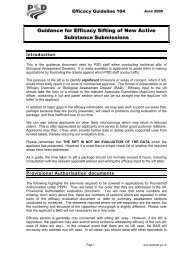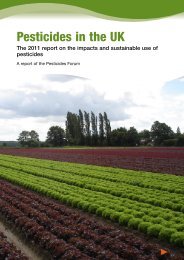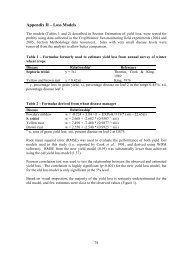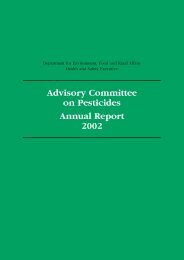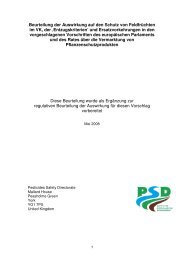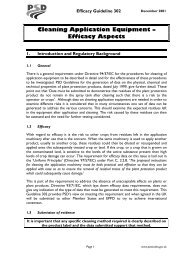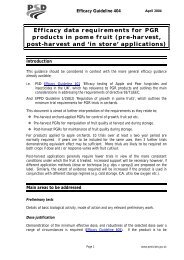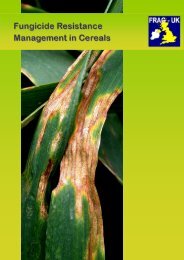Advisory Committee on Pesticides Annual Report 2001
ACP Annual Report 2001 - Pesticides Safety Directorate
ACP Annual Report 2001 - Pesticides Safety Directorate
You also want an ePaper? Increase the reach of your titles
YUMPU automatically turns print PDFs into web optimized ePapers that Google loves.
<str<strong>on</strong>g>Advisory</str<strong>on</strong>g> <str<strong>on</strong>g>Committee</str<strong>on</strong>g> <strong>on</strong> <strong>Pesticides</strong> <strong>Annual</strong> <strong>Report</strong> <strong>2001</strong><br />
The ACP agreed that the estimated exposures of operators, bystanders,<br />
workers and c<strong>on</strong>sumers were acceptable. Two minor metabolites present<br />
in wheat but not found in the rat were c<strong>on</strong>sidered by the <str<strong>on</strong>g>Committee</str<strong>on</strong>g> not<br />
to be a cause for c<strong>on</strong>cern.<br />
It was agreed that the potential for soil accumulati<strong>on</strong> was slight and the<br />
ACP c<strong>on</strong>cluded that the weight of evidence indicated an acceptable risk<br />
to n<strong>on</strong>-target organisms without the need for further data.<br />
The ACP also c<strong>on</strong>sidered potential groundwater c<strong>on</strong>taminati<strong>on</strong> and the<br />
likelihood of exceedance of the EU drinking water limit. It was noted that<br />
interpretati<strong>on</strong> of probabilistic modelling data, particularly involving preferential<br />
flow, was difficult and needed further elucidati<strong>on</strong>. However, the compound<br />
was applied at low rates and its sorpti<strong>on</strong> and persistence properties were not<br />
c<strong>on</strong>sistent with significant leaching. Overall the ACP agreed that the potential<br />
for c<strong>on</strong>taminati<strong>on</strong> of groundwater was likely to be low and was acceptable<br />
for approval.<br />
24<br />
The ACP initially required further assessment of the potential of silthiofam<br />
to accumulate in sediment and of the chr<strong>on</strong>ic risk presented to sedimentdwelling<br />
organisms. The <str<strong>on</strong>g>Committee</str<strong>on</strong>g> subsequently c<strong>on</strong>sidered a revised risk<br />
assessment based <strong>on</strong> potential cumulative depositi<strong>on</strong> scenarios in sediment<br />
and data from a chr<strong>on</strong>ic Daphnia study. It was c<strong>on</strong>cluded that the risk was<br />
acceptable for approval of silthiofam but that generic issues pertaining to<br />
exposure of sediment-dwelling organisms should be addressed.<br />
The <str<strong>on</strong>g>Committee</str<strong>on</strong>g> recommended provisi<strong>on</strong>al approval for ‘Latitude’ for use<br />
as a cereal seed treatment pending the Commissi<strong>on</strong> decisi<strong>on</strong> <strong>on</strong> inclusi<strong>on</strong><br />
of silthiofam in Annex 1 of Council Directive 91/414/EEC.<br />
Spinosad<br />
Spinosad is new macrolide insecticide with a novel mode of acti<strong>on</strong> <strong>on</strong> the<br />
insect nervous system. The active substance was also being c<strong>on</strong>sidered for<br />
inclusi<strong>on</strong> in Annex I of Directive 91/414/EEC with Netherlands acting as<br />
Rapporteur Member State.<br />
The ACP c<strong>on</strong>sidered authorisati<strong>on</strong> of ‘C<strong>on</strong>serve’ (formerly ‘NAF-313’), a<br />
suspensi<strong>on</strong> c<strong>on</strong>centrate formulati<strong>on</strong> c<strong>on</strong>taining 120 g/l of the active substance<br />
spinosad. The proposed use of the product was for the c<strong>on</strong>trol of western<br />
flower thrips (Frankliniella occidentalis) in protected ornamental plant<br />
producti<strong>on</strong>.




